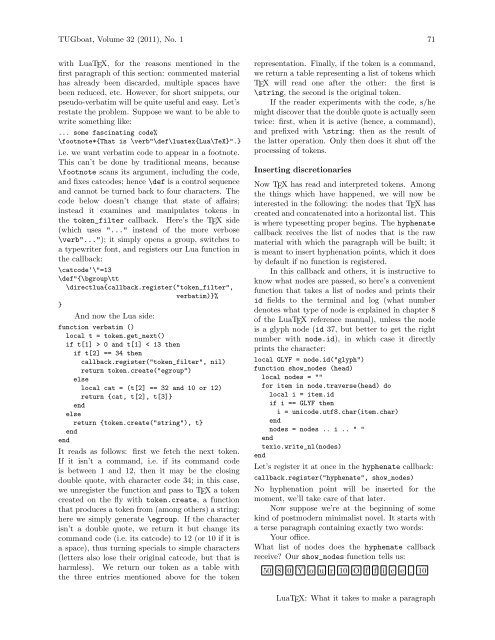LuaTEX: What it takes to make a paragraph Paul Isambert ... - TUG
LuaTEX: What it takes to make a paragraph Paul Isambert ... - TUG
LuaTEX: What it takes to make a paragraph Paul Isambert ... - TUG
Create successful ePaper yourself
Turn your PDF publications into a flip-book with our unique Google optimized e-Paper software.
<strong>TUG</strong>boat, Volume 32 (2011), No. 1 71<br />
w<strong>it</strong>h <strong>LuaTEX</strong>, for the reasons mentioned in the<br />
first <strong>paragraph</strong> of this section: commented material<br />
has already been discarded, multiple spaces have<br />
been reduced, etc. However, for short snippets, our<br />
pseudo-verbatim will be qu<strong>it</strong>e useful and easy. Let’s<br />
restate the problem. Suppose we want <strong>to</strong> be able <strong>to</strong><br />
wr<strong>it</strong>e something like:<br />
... some fascinating code%<br />
\footnote*{That is \verb"\def\luatex{Lua\TeX}".}<br />
i.e. we want verbatim code <strong>to</strong> appear in a footnote.<br />
This can’t be done by trad<strong>it</strong>ional means, because<br />
\footnote scans <strong>it</strong>s argument, including the code,<br />
and fixes catcodes; hence \def is a control sequence<br />
and cannot be turned back <strong>to</strong> four characters. The<br />
code below doesn’t change that state of affairs;<br />
instead <strong>it</strong> examines and manipulates <strong>to</strong>kens in<br />
the <strong>to</strong>ken_filter callback. Here’s the TEX side<br />
(which uses "..." instead of the more verbose<br />
\verb"..."); <strong>it</strong> simply opens a group, sw<strong>it</strong>ches <strong>to</strong><br />
a typewr<strong>it</strong>er font, and registers our Lua function in<br />
the callback:<br />
\catcode‘\"=13<br />
\def"{\bgroup\tt<br />
\directlua{callback.register("<strong>to</strong>ken_filter",<br />
verbatim)}%<br />
}<br />
And now the Lua side:<br />
function verbatim ()<br />
local t = <strong>to</strong>ken.get_next()<br />
if t[1] > 0 and t[1] < 13 then<br />
if t[2] == 34 then<br />
callback.register("<strong>to</strong>ken_filter", nil)<br />
return <strong>to</strong>ken.create("egroup")<br />
else<br />
local cat = (t[2] == 32 and 10 or 12)<br />
return {cat, t[2], t[3]}<br />
end<br />
else<br />
return {<strong>to</strong>ken.create("string"), t}<br />
end<br />
end<br />
It reads as follows: first we fetch the next <strong>to</strong>ken.<br />
If <strong>it</strong> isn’t a command, i.e. if <strong>it</strong>s command code<br />
is between 1 and 12, then <strong>it</strong> may be the closing<br />
double quote, w<strong>it</strong>h character code 34; in this case,<br />
we unregister the function and pass <strong>to</strong> TEX a <strong>to</strong>ken<br />
created on the fly w<strong>it</strong>h <strong>to</strong>ken.create, a function<br />
that produces a <strong>to</strong>ken from (among others) a string:<br />
here we simply generate \egroup. If the character<br />
isn’t a double quote, we return <strong>it</strong> but change <strong>it</strong>s<br />
command code (i.e. <strong>it</strong>s catcode) <strong>to</strong> 12 (or 10 if <strong>it</strong> is<br />
a space), thus turning specials <strong>to</strong> simple characters<br />
(letters also lose their original catcode, but that is<br />
harmless). We return our <strong>to</strong>ken as a table w<strong>it</strong>h<br />
the three entries mentioned above for the <strong>to</strong>ken<br />
representation. Finally, if the <strong>to</strong>ken is a command,<br />
we return a table representing a list of <strong>to</strong>kens which<br />
TEX will read one after the other: the first is<br />
\string, the second is the original <strong>to</strong>ken.<br />
If the reader experiments w<strong>it</strong>h the code, s/he<br />
might discover that the double quote is actually seen<br />
twice: first, when <strong>it</strong> is active (hence, a command),<br />
and prefixed w<strong>it</strong>h \string; then as the result of<br />
the latter operation. Only then does <strong>it</strong> shut off the<br />
processing of <strong>to</strong>kens.<br />
Inserting discretionaries<br />
Now TEX has read and interpreted <strong>to</strong>kens. Among<br />
the things which have happened, we will now be<br />
interested in the following: the nodes that TEX has<br />
created and concatenated in<strong>to</strong> a horizontal list. This<br />
is where typesetting proper begins. The hyphenate<br />
callback receives the list of nodes that is the raw<br />
material w<strong>it</strong>h which the <strong>paragraph</strong> will be built; <strong>it</strong><br />
is meant <strong>to</strong> insert hyphenation points, which <strong>it</strong> does<br />
by default if no function is registered.<br />
In this callback and others, <strong>it</strong> is instructive <strong>to</strong><br />
know what nodes are passed, so here’s a convenient<br />
function that <strong>takes</strong> a list of nodes and prints their<br />
id fields <strong>to</strong> the terminal and log (what number<br />
denotes what type of node is explained in chapter 8<br />
of the <strong>LuaTEX</strong> reference manual), unless the node<br />
is a glyph node (id 37, but better <strong>to</strong> get the right<br />
number w<strong>it</strong>h node.id), in which case <strong>it</strong> directly<br />
prints the character:<br />
local GLYF = node.id("glyph")<br />
function show_nodes (head)<br />
local nodes = ""<br />
for <strong>it</strong>em in node.traverse(head) do<br />
local i = <strong>it</strong>em.id<br />
if i == GLYF then<br />
i = unicode.utf8.char(<strong>it</strong>em.char)<br />
end<br />
nodes = nodes .. i .. " "<br />
end<br />
texio.wr<strong>it</strong>e_nl(nodes)<br />
end<br />
Let’s register <strong>it</strong> at once in the hyphenate callback:<br />
callback.register("hyphenate", show_nodes)<br />
No hyphenation point will be inserted for the<br />
moment, we’ll take care of that later.<br />
Now suppose we’re at the beginning of some<br />
kind of postmodern minimalist novel. It starts w<strong>it</strong>h<br />
a terse <strong>paragraph</strong> containing exactly two words:<br />
Your office.<br />
<strong>What</strong> list of nodes does the hyphenate callback<br />
receive? Our show_nodes function tells us:<br />
50 8 0 Y o u r 10 O f f i c e . 10<br />
<strong>LuaTEX</strong>: <strong>What</strong> <strong>it</strong> <strong>takes</strong> <strong>to</strong> <strong>make</strong> a <strong>paragraph</strong>

















